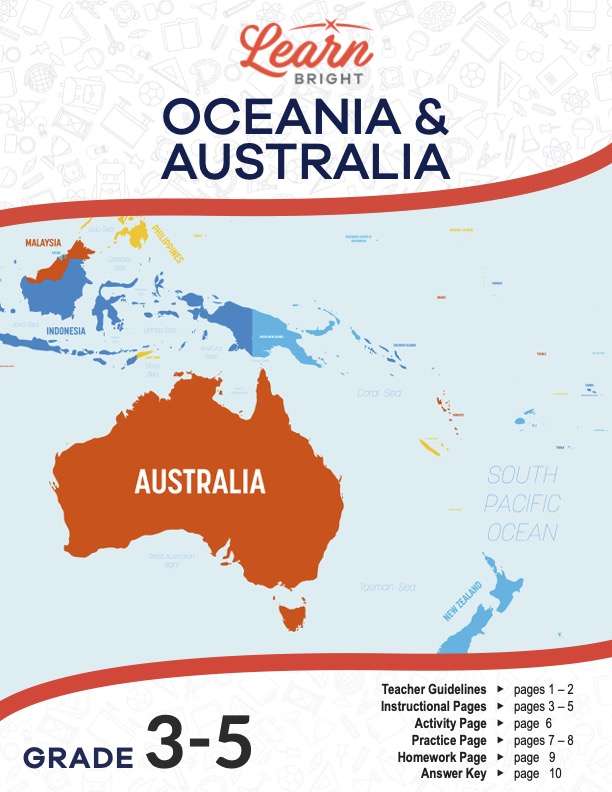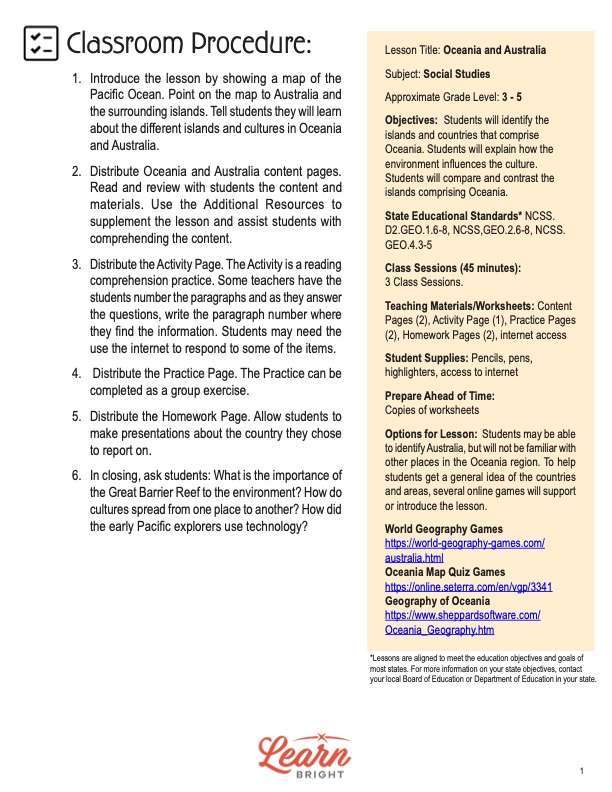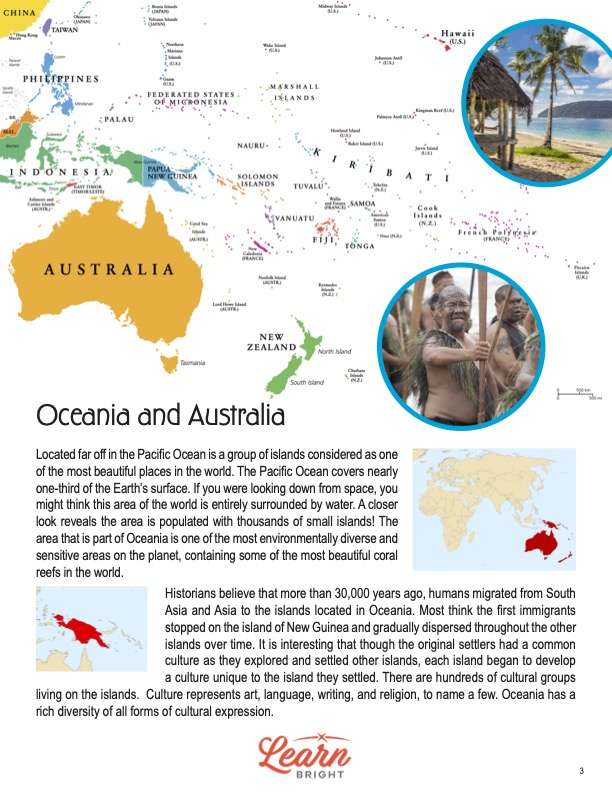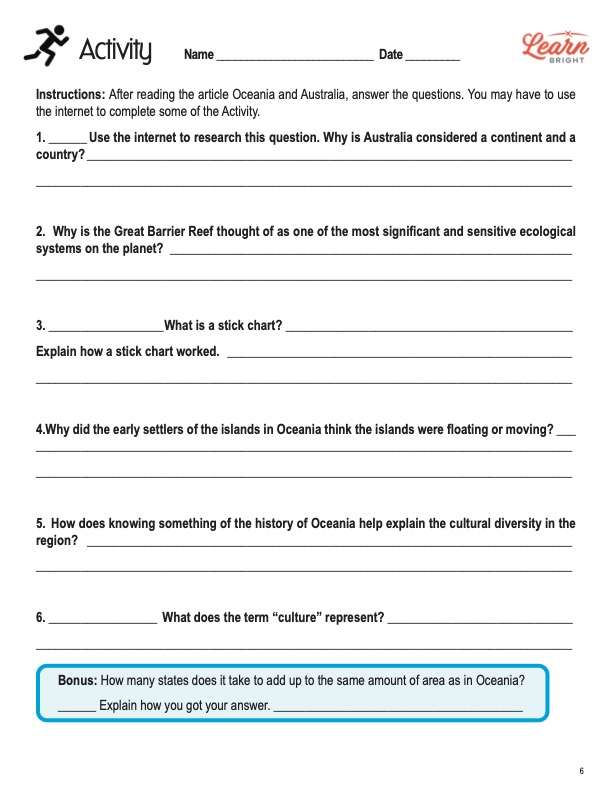Description
What our Oceania and Australia lesson plan includes
Lesson Objectives and Overview: Oceania and Australia teaches students about the islands and countries that make up the region of Oceania. Students will discover how people’s environment influences their culture. They will also compare and contrast the islands of Oceania. This lesson is for students in 3rd grade, 4th grade, and 5th grade.
Classroom Procedure
Every lesson plan provides you with a classroom procedure page that outlines a step-by-step guide to follow. You do not have to follow the guide exactly. The guide helps you organize the lesson and details when to hand out worksheets. It also lists information in the yellow box that you might find useful. You will find the lesson objectives, state standards, and number of class sessions the lesson should take to complete in this area. In addition, it describes the supplies you will need as well as what and how you need to prepare beforehand.
Options for Lesson
You can take advantage of the suggestions in the “Options for Lesson” section that offers additional activities or ideas to incorporate into the lesson plan. In this lesson, this section provides some links to various games related to Oceania. Students may be able to identify Australia, but they will not likely be familiar with other places in the Oceania region. To help students get a general idea of the countries and areas, several online games will support or introduce the lesson.
Teacher Notes
The teacher notes page provides an extra paragraph of information to help guide the lesson. It explains that this lesson provides students with a unique opportunity to study how culture spreads. You can use the blank lines to write down any other ideas or thoughts you have about the topic as you prepare.
OCEANIA AND AUSTRALIA LESSON PLAN CONTENT PAGES
History of Oceania
The Oceania and Australia lesson plan contains three pages of content. Located far off in the Pacific Ocean is a group of islands many consider one of the most beautiful places in the world. The Pacific Ocean covers nearly one-third of Earth’s surface. If you were looking down from space, you might think water entirely surrounded this area of the world. But a closer look would reveal that thousands of small islands populate the region!
The area that is part of Oceania is one of the most environmentally diverse and sensitive areas on the planet, containing some of the most beautiful coral reefs in the world. Historians believe that more than 30,000 years ago, humans migrated from South Asia and Asia to the islands of Oceania. Most think the first immigrants stopped on the island of New Guinea and gradually dispersed throughout the other islands over time.
The original settlers had a common culture. As they explored and settled other islands, each island began to develop a culture unique to the island they settled. There are hundreds of cultural groups living on the islands. Culture represents art, language, writing, and religion, to name a few. Oceania has a rich diversity of all forms of cultural expression.
Early Exploration and Modern Oceania
When we think of pioneers, we usually think of travelers crossing the land. People living in the Pacific were phenomenal sea pioneers, often traveling hundreds of miles to explore the islands and coasts. Using canoes, they developed advanced skills to navigate across the ocean. As one historian said, for anyone to attempt to cross an ocean in a canoe, they would have been very confident in their skills to find their way across and back. This means the Pacific explorers must have developed genuinely unique navigation and boat construction skills.
Students will learn that one interesting artifact historians and archaeologists found to help Pacific pioneers navigate the oceans is a stick chart. Historians believe these were developed in the Marshall Islands, one of the hundreds of islands in the area. Stick charts are a memory tool and nothing like a map or chart. Sailors would practice on dry land and then use their memory of the feel and direction of the sticks to guide them on their ocean exploration.
Currents, weather, winds, and landmarks can change, of course. That meant sailors on voyages had to rely on the navigator’s memory to get them to and from their destination safely. In the early years of exploration, the inhabitants of the islands thought the islands were floating and moving. Later they learned the changing conditions in the ocean made caused this false assumption. Knowing something about the history of the people living in the area helps us to understand why there is so much cultural diversity in Oceania.
About Australia
Most geographers say Oceania consists of 14 Pacific countries—several small islands, and Australia. Australia is unique as it is both a continent and a country. As the name implies, the area known as Oceania is mostly water. The region covers more than 3.2 million square miles and has a population of nearly 42 million people. The Indian and Pacific Oceans surround the area. Oceania is home to the Great Barrier Reef, one of the most diverse and environmentally important places on the planet. The Great Barrier Reef is the largest coral reef in the world.
Australia is the largest island in Oceania. About 25 million people live in Australia, which is more than half of the entire population of Oceania. Though the island is considered a continent, in comparison to the other continents, Australia is the smallest. Even though it is the smallest continent, Australia is the sixth-largest country in the world!
The country divides into six large states. Approximately 35% of the country is desert. The other 65% is what they call the Outback, a vastly remote area. The Outback is the cultural and historical center of Australia, containing a very diverse population of native peoples. Many living in the Outback area retain the cultural traditions of their native ancestors.
The Aborigines are descendants of migrants from Africa. Historians believe they left the African continent about 75,000 years ago and migrated to settle in Australia about 60,000 years ago. The Aborigine people are known for their skills in arts and crafts. They are also able to live in an exceptionally harsh climate of the Australian Outback.
OCEANIA AND AUSTRALIA LESSON PLAN WORKSHEETS
The Oceania and Australia lesson plan includes three worksheets: an activity worksheet, a practice worksheet, and a homework assignment. Each one will help students solidify their grasp of the material they learned throughout the lesson. You can refer to the classroom procedure guidelines to know when to hand out each worksheet.
COMPREHENSION QUESTIONS ACTIVITY WORKSHEET
For the activity, students will answer a series of questions based on what they learned during the lesson. They will use both the content pages and the internet to complete the assignment.
LABEL THE MAP PRACTICE WORKSHEET
The practice worksheet provides students with a map of Oceania. Students must label the different countries. They can also include cities, oceans, seas, and other areas of geographical interest.
OCEANIA AND AUSTRALIA HOMEWORK ASSIGNMENT
Using the list of Oceania countries in the contents pages, students will choose one to write about. They will write a five-paragraph report about the country and circle the one they chose on the Practice map.
Worksheet Answer Keys
There are answer keys for the practice and homework worksheets at the end of the lesson plan document. Given the nature of the homework assignment, students answers will vary widely. The practice answer key provides much more on the map than students might include. If you choose to administer the lesson pages to your students via PDF, you will need to save a new file that omits these pages. Otherwise, you can simply print out the applicable pages and keep these as reference for yourself when grading assignments.










